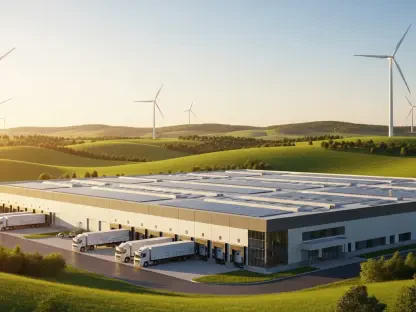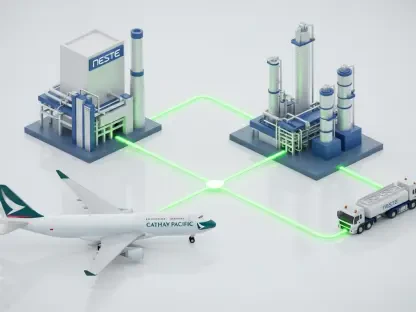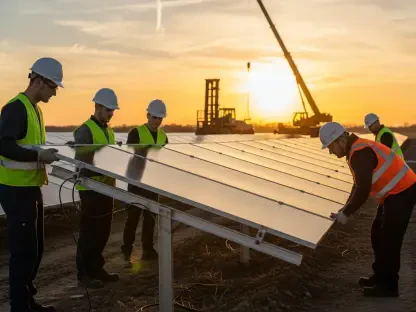As the United States pushes towards decarbonizing its energy sector, the solar energy industry faces a critical bottleneck: a severe shortage of qualified labor. Energy companies are scrambling to meet ambitious installation schedules but are hampered by the lack of a sufficient workforce. Amidst this crisis, automation emerges as a potential game-changer. This article delves into how robots, like AES Corporation’s Maximo, are stepping in to alleviate the labor crunch, the broader industry context, and the potential consequences for job quality and the future of renewable energy.
The Challenge: A Severe Labor Shortage
The Extent of the Labor Shortage
Energy companies in the U.S. are struggling to keep up with solar panel installation targets due to an acute lack of qualified labor. The labor shortfall has become a significant challenge, delaying numerous construction projects. According to a New York Times survey, nearly 44 percent of solar energy companies find it “very difficult” to source qualified labor, underscoring the gravity of the situation. This shortage is not merely an inconvenience but a critical bottleneck that threatens the timely completion of crucial renewable energy projects, putting the entire decarbonization agenda at risk.
The difficulties in sourcing qualified labor are exacerbated by the rapid growth of the solar industry, which has outpaced the development of a sufficiently skilled workforce. New technologies and installation techniques require specialized skills that are in short supply. Training programs and certification processes have not kept pace with industry needs, leading to a widening gap between the demand for labor and the available talent pool. Consequently, companies are often forced to delay projects or operate with inadequate staffing, leading to inefficiencies and increased costs.
The Impact on Renewable Energy Goals
The labor shortage presents a formidable hurdle in the pursuit of renewable energy expansion. The ambitious decarbonization targets set by both the industry and federal mandates necessitate a rapid scaling up of solar energy capacity. However, without enough workers, achieving these targets appears increasingly difficult. Estimates suggest that by 2033, around 475,000 workers will be required to meet the projected demand for solar energy production, nearly double the current workforce. This projected gap highlights the urgent need for innovative solutions to address the labor crisis and maintain momentum towards a sustainable energy future.
The implications of this labor shortfall extend beyond delayed projects. The inability to meet installation targets could undermine public and political support for renewable energy initiatives, creating a vicious cycle where stalled progress leads to reduced investment and further setbacks. Additionally, the labor shortage raises concerns about the quality and safety of installations, as overworked and undertrained crews may be more prone to errors. The industry’s credibility and long-term success depend on its ability to deliver on its promises, making the resolution of the labor shortage a critical priority.
Enter Automation: The Case of AES Corporation
Maximo: A Robotic Solution
AES Corporation, the largest renewable energy company in the U.S., has developed an innovative solution to the labor crisis: a robot named Maximo. Resembling the size of a pickup truck, Maximo uses suction cups on an extendable arm to lift and place heavy solar panels. Equipped with artificial intelligence (AI) and computer vision, Maximo ensures precise placement and operates at twice the speed of human workers, offering significant efficiency gains at half the labor cost. This robotic marvel represents a significant leap forward in the adoption of automation within the solar industry, highlighting the potential for technology to overcome human resource constraints.
Maximo’s development underscores AES Corporation’s commitment to pioneering advanced solutions that align with their renewable energy ambitions. The robot’s design incorporates cutting-edge AI algorithms that enable it to learn from each installation, continually improving its performance. Its computer vision system allows for real-time adjustments, ensuring optimal positioning of panels regardless of site-specific challenges. This adaptability makes Maximo an invaluable asset in a variety of installation scenarios, from large-scale solar farms to smaller rooftop systems. As the first of its kind, Maximo sets a precedent for future robotic innovations in the field of renewable energy.
Benefits and Efficiency Gains
Maximo’s deployment demonstrates the transformative potential of automation. The robot’s ability to work continuously without the physical limitations faced by human workers translates to faster installation rates and reduced labor costs. This increased efficiency is crucial for energy companies like AES Corporation, which must rapidly expand their solar capacity to meet heightened energy demands and climate targets. By leveraging automation, these companies can mitigate the impacts of the labor shortage and ensure timely completion of projects, maintaining their competitive edge in a rapidly evolving market.
The economic benefits of Maximo extend beyond immediate labor savings. Reduced installation times lead to faster project completion, allowing companies to capitalize on incentives and subsidies designed to promote renewable energy adoption. Moreover, the improved precision and consistency of robotic installations can enhance the overall performance and lifespan of solar systems, resulting in greater long-term returns on investment. The success of Maximo’s initial deployments could pave the way for broader adoption of robotic solutions across the industry, driving further innovations and setting new standards for efficiency and quality.
Broader Industry Trends: Automation as Necessity
The Growing Dependency on Automation
The reliance on robotic solutions is not limited to AES Corporation. The broader renewable energy industry is increasingly turning to automation as a means to navigate the labor shortage. Political commitments to expand clean energy, such as those by President Joe Biden, underscore the urgency for innovative approaches to meet renewable energy goals. The necessity of automation in filling the labor gap becomes evident as companies strive to avoid falling behind on their decarbonization plans. As more firms recognize the value of automated technologies, the integration of robots into solar installation processes is likely to become a standard industry practice.
The trend towards automation reflects a broader shift in the renewable energy sector, where technological advancements are seen as key enablers of growth and sustainability. From automated drones used for site surveys to AI-powered energy management systems, the industry is embracing a wide range of innovations to optimize operations and enhance performance. This technological revolution is not just a response to current labor challenges but a strategic move to future-proof the industry against potential disruptions. By investing in automation, companies position themselves to meet future demands and regulatory requirements more effectively, ensuring the continuity and expansion of their renewable energy projects.
Balancing Efficiency and Job Quality
While automation solves immediate labor constraints, it introduces a complex dynamic regarding job quality. The BlueGreen Alliance, representing a coalition of labor unions and environmental groups, acknowledges the productivity benefits of automation but raises concerns about its impact on job quality. Automated solutions may not always align with the goal of creating high-paying, unionized jobs, highlighting a potential conflict between efficiency and employment quality within the renewable energy sector. This tension points to the need for thoughtful integration of technology, ensuring that the benefits of automation do not come at the expense of the workforce’s well-being and economic security.
The transition to automation requires a careful balancing act to preserve the social and economic benefits of job creation while harnessing the efficiencies of technology. Policymakers, industry leaders, and labor representatives must collaborate to develop frameworks that support both technological innovation and workforce development. This might include investing in re-skilling programs to help workers transition to new roles created by automation, ensuring fair wages and working conditions, and fostering a culture of continuous learning and adaptation. By addressing these concerns proactively, the industry can create a more inclusive and resilient workforce capable of driving the renewable energy transition.
Future Prospects and Developments
Planned Deployments
Looking ahead, Maximo is slated to assist with installations at a large-scale solar-plus-battery project in the California desert in 2024, aimed at powering Amazon data centers. The success of this initiative could pave the way for broader adoption of robotic solutions in solar panel installations, enabling more projects to meet their schedules despite labor shortages. This high-profile deployment will serve as a critical test case, demonstrating the scalability and reliability of robotic automation in large-scale renewable energy projects and setting a benchmark for future technological integrations.
The California project represents a significant milestone in the journey towards widespread automation in the solar industry. By partnering with tech giants like Amazon, AES Corporation can showcase the practical benefits of robotic solutions to a global audience. Successful implementation at this scale will provide valuable insights into the operational challenges and opportunities associated with deploying robots in complex environments. Additionally, this project highlights the symbiotic relationship between renewable energy producers and technology companies, illustrating how collaborative efforts can drive innovation and accelerate the transition to a sustainable energy future.
Scaling Up Robotic Solutions
As the United States advances its efforts to decarbonize the energy sector, the solar energy industry encounters a significant hurdle: a critical shortage of skilled labor. Energy companies are under pressure to adhere to aggressive installation timelines but are thwarted by an inadequate workforce. Within this predicament, automation presents a promising solution. This article explores how robotic systems like AES Corporation’s Maximo are stepping up to address the labor deficiency, the broader implications for the industry, and the potential impacts on job quality and the future of renewable energy. Robots like Maximo don’t just offer a temporary fix; they signal a transformative shift that could redefine how solar energy projects are executed. As these automated systems increasingly take on tasks traditionally performed by humans, it raises essential questions about the evolving nature of jobs in the renewable energy sector. This situation compels us to consider the role of technology in shaping a more efficient, but potentially less human-dependent, future for solar energy.









